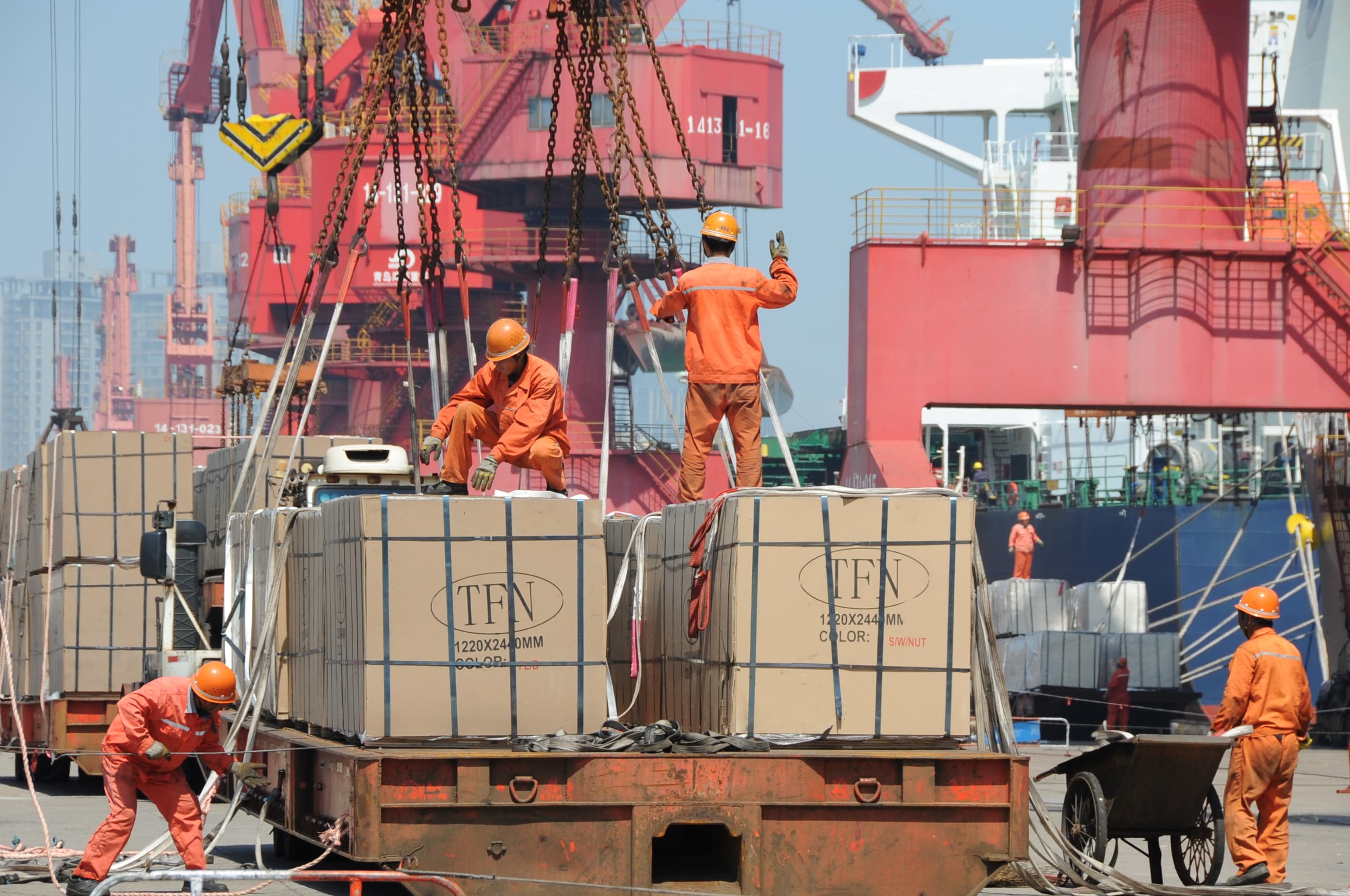
- International investment firms have changed their forecasts for China’s GDP nearly every month so far this year, with JPMorgan making six revisions since January.
- This is according to a CNBC analysis of the companies’ notes.
- The average prediction among six companies CNBC studied now is 5.1%, close to the “around 5%” target Beijing announced in March.
Workers load goods for export onto a crane at a port in Lianyungang, Jiangsu Province, China, June 7, 2019.
Reuters
BEIJING – International investment firms have changed their forecasts for China’s GDP nearly every month so far this year, with JPMorgan making six revisions since January.
This is according to a CNBC analysis of the companies’ notes. JPMorgan did not immediately respond to a request for comment.
The US investment bank recently cut its forecast for Chinese GDP in July to 5%, down from 5.5% previously.
That came along with cuts from Citi and Morgan Stanley this month to 5%.
The average prediction among six companies CNBC studied now is 5.1%, close to the “around 5%” target Beijing announced in March.
Citi’s latest forecast marks the company’s fourth changeover this year. Morgan Stanley has revised its forecast only once since it was set in January.
During the same period, Nomura changed its forecast four times, while UBS revised it three times and Goldman Sachs changed its forecast twice.
Investment banks mostly revised their forecasts higher early this year after China’s initial recovery, after three years of tough Covid restrictions.
The latest cuts come as recent economic data points to slower-than-expected growth and the authorities show little inclination to initiate broad-based stimulus. Gross domestic product in the second quarter rose 6.3% from a year ago, missing the 7.3% growth expected by analysts polled by Reuters.
However, the disappointment in second-quarter GDP growth stemmed from official revisions to quarterly growth in China last year, according to Logan Wright and a team from Rhodium Group.
Analysts said in the July 17 report that the resulting lower figure helps Beijing make a case for supporting the economy. “Understand what you see in this year’s GDP data: these are artificial narratives for different audiences, not reports on China’s economic performance.”
The NBS did not immediately respond to CNBC’s request for comment.
Rather than releasing multiple readings of the data, the bureau reveals quarterly GDP relatively soon after the end of the period, and releases revisions later.
The Census Bureau also released public statements about penalizing local governments for falsifying data. The accuracy of official data in China has long been questioned.
Goldman Sachs on Friday signaled seasonal revisions, but maintained its 5.4% forecast for China’s growth. “Online, we don’t think the surprises are either consistent or large enough to make significant adjustments to our forecast for growth in China this year.”
Researchers have sought alternatives to measuring growth.
One organization is US-based China Beige Book, which claims to regularly survey companies in China in order to release reports on the economic environment.
Earlier this year, the company’s data showed “no wave of retaliatory spending or a devastating recovery,” said Shehzad Qazi, New York-based managing director of China Big Book.
“Wall Street’s predictions of explosive growth in China were initially based on hype, then bolstered by bloated Chinese GDP prints in early 2023.”
Qazi testified this month at a hearing of the US House Committee on the Communist Party of China.
Investment bank research is often known as sell side, Because it aims to inform buyers about financial products and company shares.
In the case of China, Qazi notes, “Investment banks are not only motivated to sell the ‘boom China’ story, but given their business interests in China, they are also unwilling to publish any opinions that could be seen as critical of China’s economy.”
The World Bank and the International Monetary Fund have also made regular economic forecasts for China and other countries. However, their reporting schedule means that forecasts may not exactly match the current economic situation.
In June, the World Bank raised its forecast for Chinese growth this year to 5.6%, from 4.3% previously.
The International Monetary Fund in April raised its forecast for China’s GDP to 5.2%, up from 4.4% previously. This month, an IMF spokesperson noted that growth was slowing in China, and said the “updated outlook” would be reflected in the International Monetary Fund’s next World Economic Outlook report.
Chinese officials have confirmed in the past several weeks that the country is on track to reach its annual growth target of around 5%.
Of the six investment companies CNBC looked at, the highest forecast for Chinese GDP so far this year was JPMorgan’s figure of 6.4% — when the bank revised for the second time in April alone.
In all, the company’s forecast range was extended by 1.4 percentage points, the largest number of those included in a CNBC analysis.
Although companies and investors have expressed uncertainty about China’s economic path in the near term, analysts expect that growth in the world’s second largest economy will continue to rebound in the long term.
“Overall, there is an emerging case of a cyclical recovery in the Chinese economy in early 2024, even without any meaningful political support in the second half of 2023,” Rhodium analysts said.
Looking at four quarters, they said, a continued recovery in household consumption should help boost service sector employment, while industrial inventories will likely need to be restocked going forward.





More Stories
3M Surges Most in 36 Years as New CEO Boosts Earnings Outlook
Tesla Robotaxi is now set to be revealed on October 10, and Elon hints at ‘something else’
Elon Musk Claims Tesla Will Start Using Humanoid Robots Next Year | Elon Musk